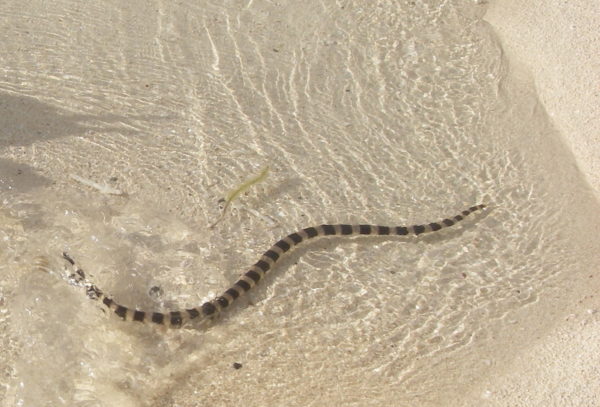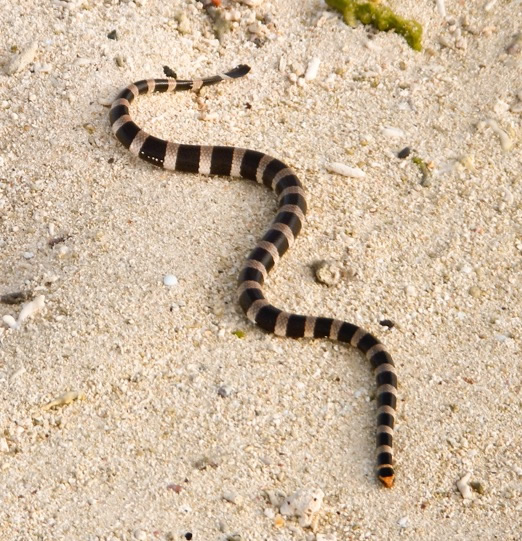Published in the Ocean Watch column, Honolulu Star-Advertiser © Susan Scott
Friday, September 12, 2008
A reader in South Africa e-mailed me that she saw a television show, “Survivor Fiji,” in which a banded sea snake gave birth through what appeared to be its mouth.
“Is that possible?” Barbara asks. “How do sea snakes reproduce?”

It’s unwise to ever say something is impossible in nature, but in this case I think it’s safe. No, it is not possible for sea snakes to give birth by mouth. Here’s why.
Female sea snakes have two ovaries connected to tubes called oviducts that lead to the birth opening at the base of the tail. This multipurpose opening, called the cloaca, also serves as the entry for sperm and the exit for body wastes.
Male sea snakes have two penises, also at the base of the tail. During courtship the male’s contracting muscles fill its penises with blood, turning them inside out. The male inserts only one of these into a female’s cloaca. Apparently, the second penis is just a spare.
Sea snake copulation takes place underwater and takes such a long time, the couple must come up for air. The female controls the timing of these immersions and submersions, and since the male is stuck firmly inside the female until fertilization is finished, he must gasp for a breath when she does.
After the male has done his job, the female incubates the fertile eggs inside her body from four to 11 months (depending on species) where they then hatch. She expels the live hatchlings into the water through her cloaca.
I thought perhaps what Barbara saw was the snake protecting or carrying its hatchlings in its mouth, like crocodiles. But no. Once the newborns are in the water, they’re on their own. Sea snakes provide no parental care for their offspring.
While I was reading up on sea snake reproduction, I came across a paper about garter snake mating that is so amazing I have to share it.
When a male garter snake is in the mood, he lies over a female and contracts his muscles from head to tail. Researchers once thought this was the way the male checked the female’s receptivity, but there’s far more to it than that.
The snake lung is extremely long, extending along most of the body (true in sea snakes, too). Because the rear part of the lung doesn’t do any gas exchanging, it’s filled with oxygen-depleted air.
What the male garter snake is doing with his pulses is pushing this dead air forward so the female becomes temporarily oxygen deprived. Her natural response to this stress is a gaping of the cloaca, a tactic that sometimes repels predators through the release of feces and musk.
In this case, though, it simply gives the male an opening, so to speak, and he’s able to fulfill his mission of passing along his genes.
But back to the reef. Another group of snakes called sea kraits straddle the marine and terrestrial worlds. Females kraits are larger than the males and eat conger eels. Males eat
morays. After their catches, both sexes come ashore to rest and digest their meals.

Female sea kraits lay four to 20 eggs on land, leaving them to hatch and find the ocean on their own. So no possible maw delivery there, either.
I don’t know what Barbara saw on TV, but if the producers of “Survivor Fiji” implied sea snakes give birth through their mouths, well, they’re selling their viewers a load of snake oil.